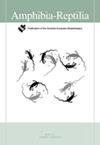短吻鳄抓钩:美洲短吻鳄的脚踏锚定(密西西比短吻鳄)
IF 1.3
4区 生物学
Q3 ZOOLOGY
引用次数: 0
摘要
在进食等非运动行为中,为了防止身体向前移动,美洲鳄(短吻鳄)将后脚保持垂直,然后将脚推入衬底,使足背与衬底形成接触区域。在这里,这种形式的支撑被称为踏板锚固。本研究的目的是描述踏板锚定,并证明它是否涉及鳄鱼的后脚(pes)和基底之间的相互作用,不同于在运动过程中看到的相互作用。短吻鳄的足迹分别在野外、野外对照试验和实验室的泥道上进行了研究;在每个场景中,拍摄了机车和脚踏的固定轨道,用巴黎石膏浇铸,然后对浇铸的特征进行量化。统计分析表明,野生轨道的差异更大,可能反映了鳄鱼的体型和速度范围更大,并表明在运动试验中使用的泥轨道没有产生显著的伪影。同一短吻鳄在同一基材上运动和脚踏固定过程中产生的足迹,在主成分分析中产生了显著不同的数量特征、不同的Pearson相关系数矩阵和不同的性状分布模式。这些结果都支持这样的结论,即踏板锚定涉及到与运动过程中发生的踏板与基底之间的根本不同的相互作用。本文章由计算机程序翻译,如有差异,请以英文原文为准。
The gator grapnel: pedal anchoring in the American alligator (Alligator mississippiensis)
To resist forward displacement of their body during non-locomotor behaviors such as feeding, American alligators (Alligator mississippiensis) hold their hindfeet vertical, then push the foot into the substrate so that the dorsum of the foot forms a contact area with the substrate. Herein this form of bracing is termed pedal anchoring. The purpose of the present study was to describe pedal anchoring and to demonstrate whether it entailed interaction between the hindfoot (pes) of Alligator and the substrate that differed from the interactions seen during locomotion. Alligator tracks were studied in the wild, during controlled field trials, and on a mud trackway in the laboratory; in each setting locomotor and pedal anchoring tracks were photographed, cast in Plaster of Paris, then features of the casts quantified. Statistical analysis demonstrated greater variation in the wild tracks, presumably reflecting the larger size and velocity ranges of the alligators involved, and suggested that the mud trackway used during the locomotor trials did not create significant artifact. Tracks produced during locomotion and pedal anchoring by the same alligators, on the same substrate, yielded significantly different quantitative features, different matrices of Pearson correlation coefficients, and different patterns of character distribution following Principal Component Analysis. These results all support the conclusion that pedal anchoring involves fundamentally different interaction between the pes and the substrate than occurs during locomotion.
求助全文
通过发布文献求助,成功后即可免费获取论文全文。
去求助
来源期刊

Amphibia-Reptilia
生物-动物学
CiteScore
3.10
自引率
6.20%
发文量
39
审稿时长
6-12 weeks
期刊介绍:
Amphibia-Reptilia is a leading European multi-disciplinary journal devoted to most of the aspects of herpetology: ecology, behaviour, evolution, conservation, physiology, morphology, paleontology, genetics, and systematics.
Amphibia-Reptilia publishes high quality original papers, short-notes, reviews, book reviews and news of the Societas Europaea Herpetologica (SEH). The Societas Europaea Herpteologica (SEH) website is located at: www.seh-herpetology.org.
 求助内容:
求助内容: 应助结果提醒方式:
应助结果提醒方式:


